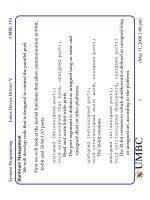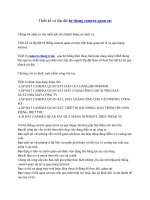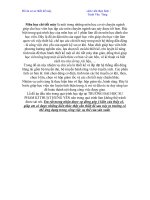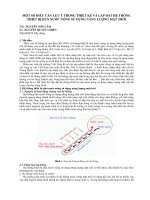Thiết kế và lập trình hệ thống - Chương18
Bạn đang xem bản rút gọn của tài liệu. Xem và tải ngay bản đầy đủ của tài liệu tại đây (2.09 MB, 12 trang )
Systems Design & Programming Coprocessor CMPE 310
1 (Mar. 1, 2002)
UMBC
U M B C
U
N
I
V
E
R
S
I
T
Y
O
F
M
A
R
Y
L
A
N
D
B
A
L
T
I
M
O
R
E
C
O
U
N
T
Y
1
9
6
6
Coprocessor Basics
The 80x87 is able to multiply, divide, add, subtract, find the sqrt and calculate
transcendental functions and logarithms.
Data types include 16-, 32- and 64-bit signed integers; 18-digit BCD data; and
32-, 64- and 80-bit (extended precision) floating-point numbers.
The directives dw, dd and dq are used for declaring signed integer stor-
age while dd, dq and dt are used for floating-point.
Converting from decimal to floating-point is accomplished:
• Convert the decimal number into binary.
• Normalize the binary number.
• Calculate the biased exponent.
• Store the number in the floating-point format.
Bias is 0x7F, 0x3FF and 0x3FFF for the 3 floating-point number types.
100.25 = 1100100.01
1100100.01 = 1.10010001 x 2
6
110 + 01111111 = 10000101
Sign = 0; Exponent = 10000101;
Significand = 10010001000000000000000
Systems Design & Programming Coprocessor CMPE 310
2 (Mar. 1, 2002)
UMBC
U M B C
U
N
I
V
E
R
S
I
T
Y
O
F
M
A
R
Y
L
A
N
D
B
A
L
T
I
M
O
R
E
C
O
U
N
T
Y
1
9
6
6
Coprocessor Basics
Special Rules:
The number 0 is stored as all 0s (except for the sign bit).
+/- infinity is stored as logic 1s in the exponent, with a significand of all 0s.
Sign bit is used to represent +/- infinity.
A NAN (not-a-number) is an invalid floating-point r esult that has all 1s in
the exponent with a significand that is NOT all zeros.
Converting from floating-point to decimal is accomplished:
Separate the sign-bit, biased exponent, and significand.
Convert the biased exponent into a true exponent by subtracting the bias.
Write the number as a normalized binary number.
Convert it to a de-normalized binary number.
Convert the de-normalized binary number to decimal.
Sign = 1; Exponent = 10000011;
Significand = 10010010000000000000000
100 = 10000011 - 01111111
1.1001001 x 2
4
11001.001
-25.125
Systems Design & Programming Coprocessor CMPE 310
3 (Mar. 1, 2002)
UMBC
U M B C
U
N
I
V
E
R
S
I
T
Y
O
F
M
A
R
Y
L
A
N
D
B
A
L
T
I
M
O
R
E
C
O
U
N
T
Y
1
9
6
6
Coprocessor Basics
The 80x87 executes 68 different instructions.
Basic structure of the co-processor.
data
buffer
Control Reg
Status Reg
bus tracking
Exceptions
Exponent
module
Instruction
decoder
Operand
queue
Shifter
Arith.
module
Temporary
Registers
(7)
(6)
(5)
(4)
(3)
(2)
(1)
(0)
80-bit wide stack
Control Unit
Numeric
Execution
Unit
Tag Register
Note: These
numbers are
always rel-
ative to the
Stack Top.
Systems Design & Programming Coprocessor CMPE 310
4 (Mar. 1, 2002)
UMBC
U M B C
U
N
I
V
E
R
S
I
T
Y
O
F
M
A
R
Y
L
A
N
D
B
A
L
T
I
M
O
R
E
C
O
U
N
T
Y
1
9
6
6
Coprocessor Status Register
The registers in the coprocessor stack always contain 80-bit extended preci-
sion data.
Memory data, of course, can assume other representations. Therefore,
conversions occur during transfers.
Status register:
FSTSW AX (Floating-point STore Status Word).
An instruction that transfers data between the coprocessor and the
AX register.
Error conditions can be checked in your program by examining bits of
this status word.
You can use the TEST instruction to test bits or the SAHF instruction
to transfer the left-most 8 bits to the EFLAGs register.
IEDEZEOEUEPEESC0C1C2Stack TopC3B
Divide by 0.
Overflow
SF
Systems Design & Programming Coprocessor CMPE 310
5 (Mar. 1, 2002)
UMBC
U M B C
U
N
I
V
E
R
S
I
T
Y
O
F
M
A
R
Y
L
A
N
D
B
A
L
T
I
M
O
R
E
C
O
U
N
T
Y
1
9
6
6
Coprocessor Status/Control Register
For example:
Control Register:
This register selects precision, rounding control and infi nity control.
For example, a value of 00 for P and C sets single precision mode.
R and C control rounding, e.g. round down, up or truncate toward 0.
fdiv DATA1
fstsw ax
test ax, 4
jnz DIVIDE_ERROR
;Copy status reg to AX
;Test bit position 2
fcom DATA1
fstsw ax
sahf
je ST_EQUAL
jb ST_BELOW
ja ST_ABOVE
;Copy status bits to flags.
;Compare DATA1 to ST0 and set status.
IMDMZMOMUMPMCPCRIC









